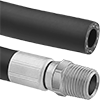Filter by
Material
Washer Material
Nut Type
Hex Nut Profile
Thread Type
Thread Direction
Performance
Thread Spacing
Locking Type
Thread Pitch
Specifications Met
Thread Fit
Tube Material
DFARS Specialty Metals
Body Material
Fastening and Joining

Cap Nuts
Cover and protect threads while adding a finished look; also known as acorn nuts
208 products
Power Transmission
Fluid Handling
Building and Machinery Hardware
Electrical
Fabricating and Machining
Material Handling













































































